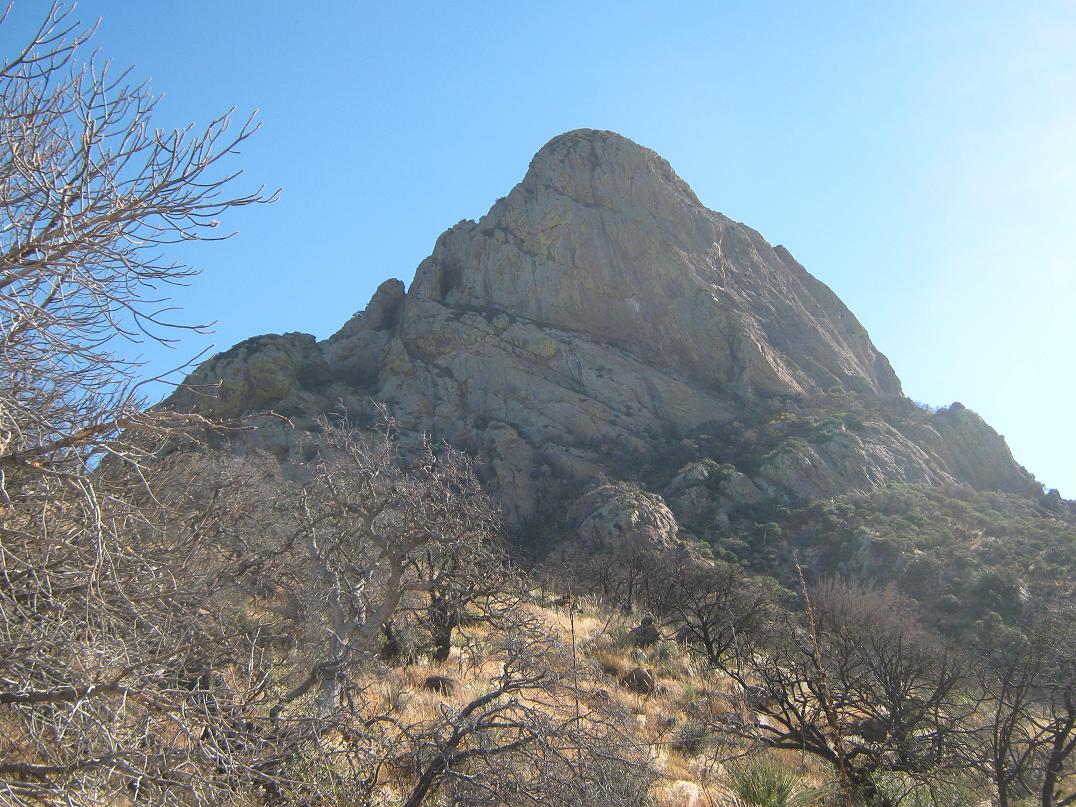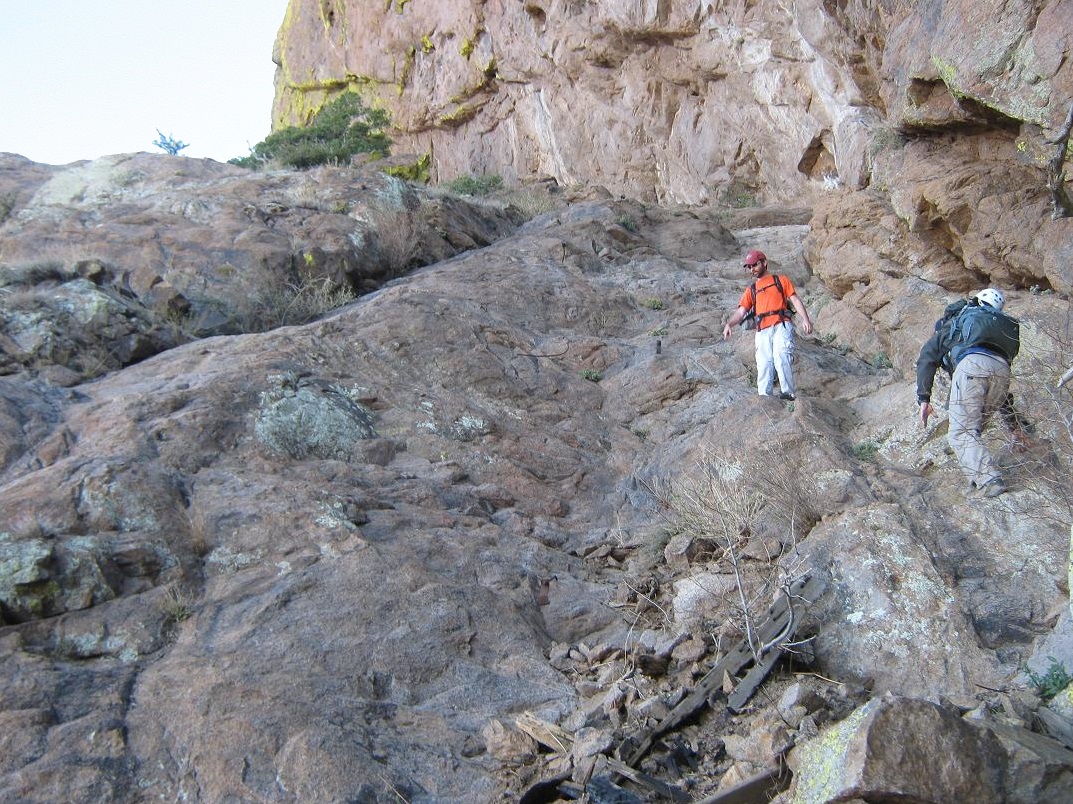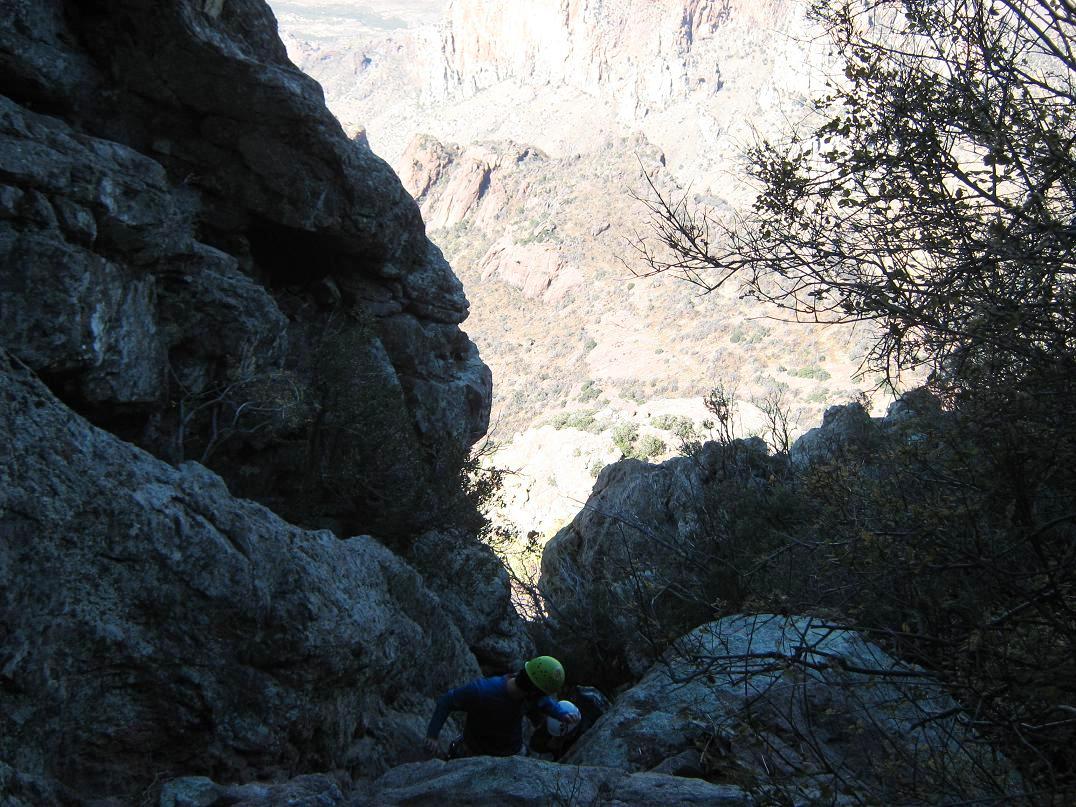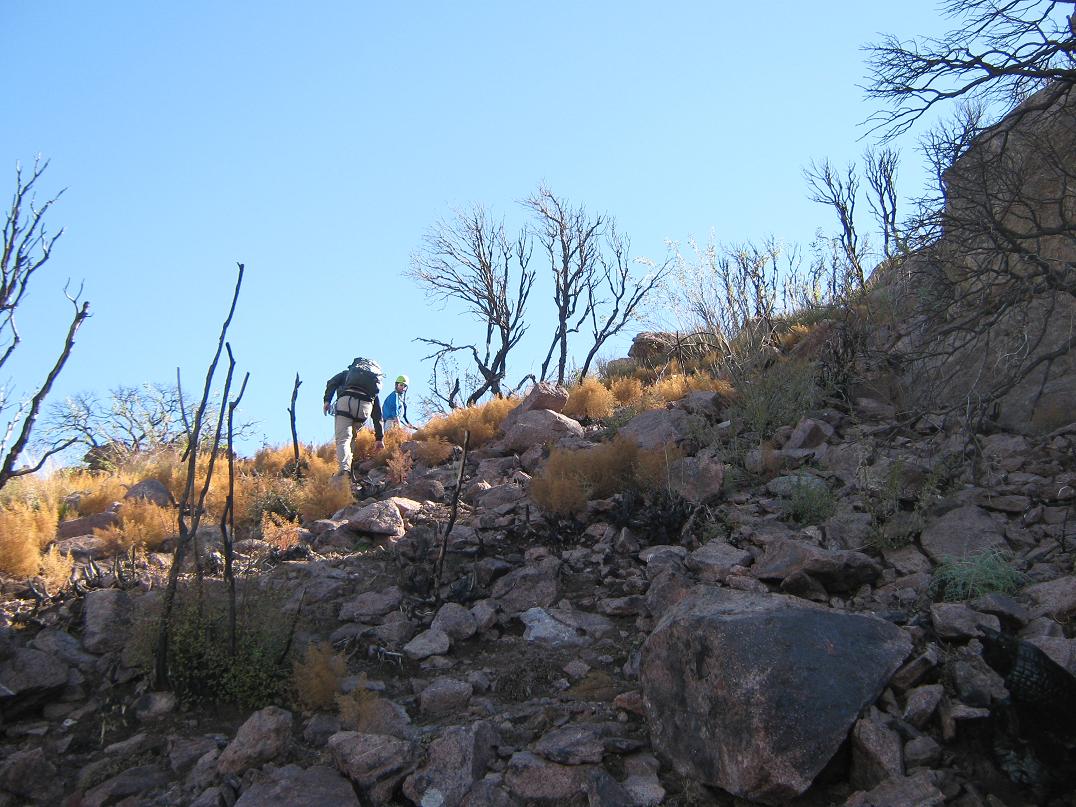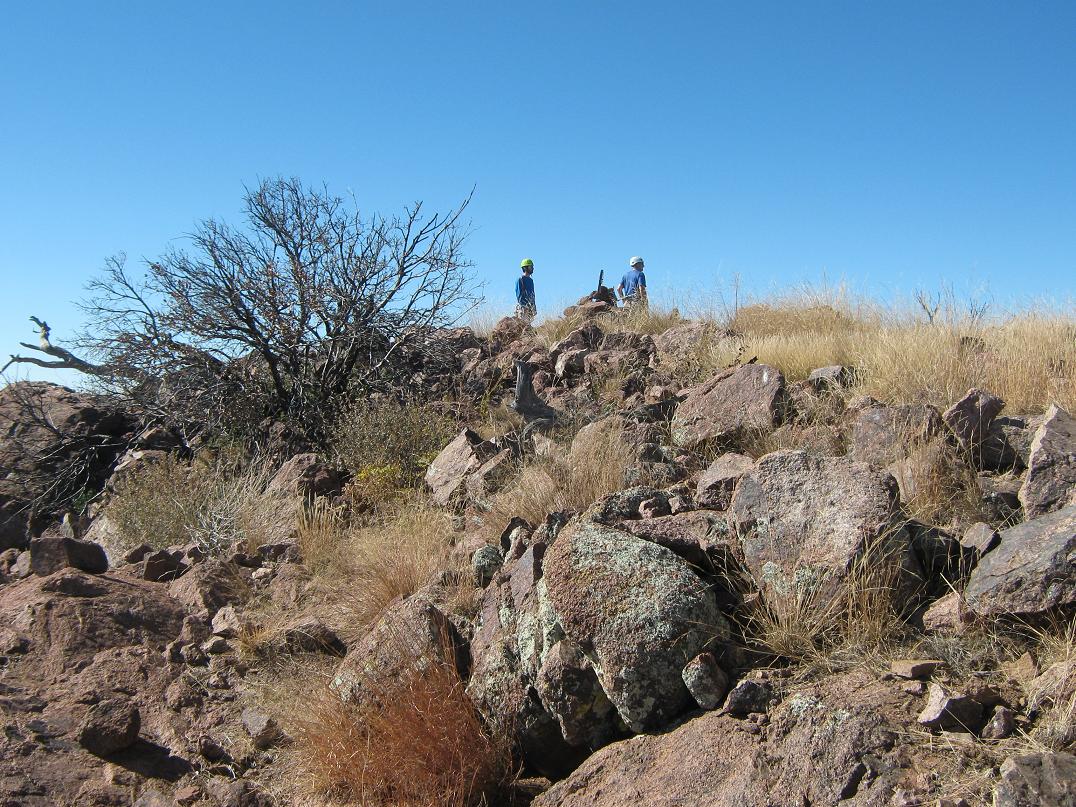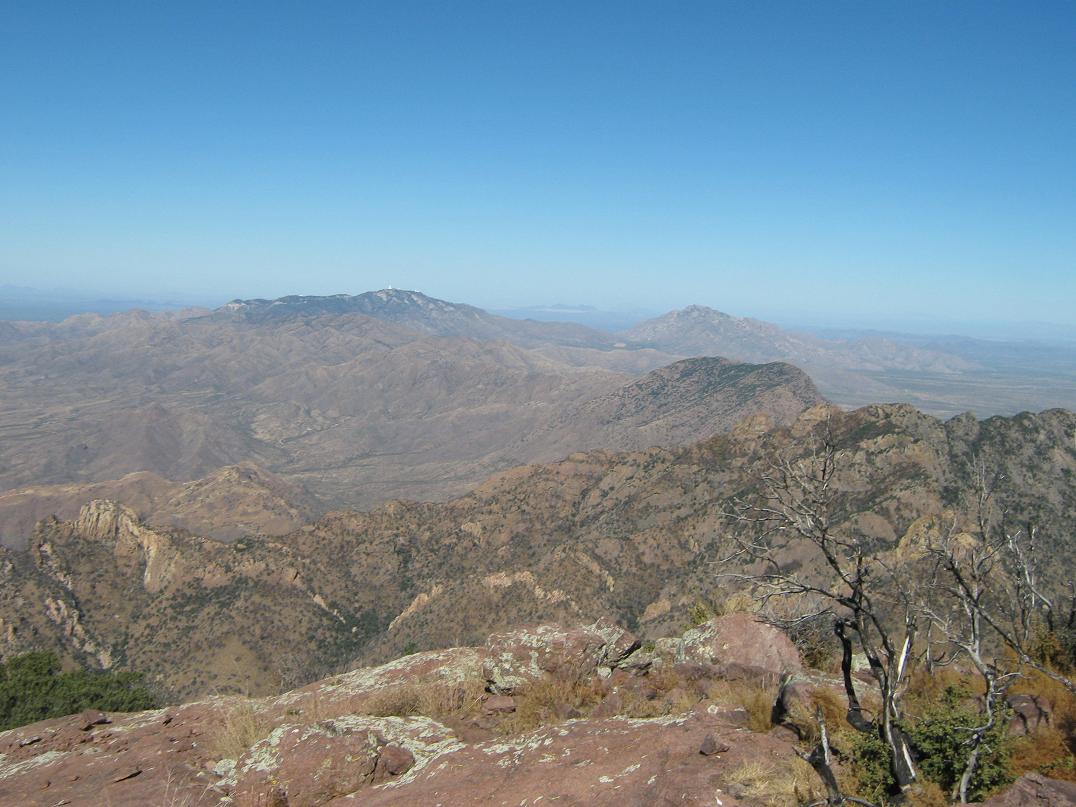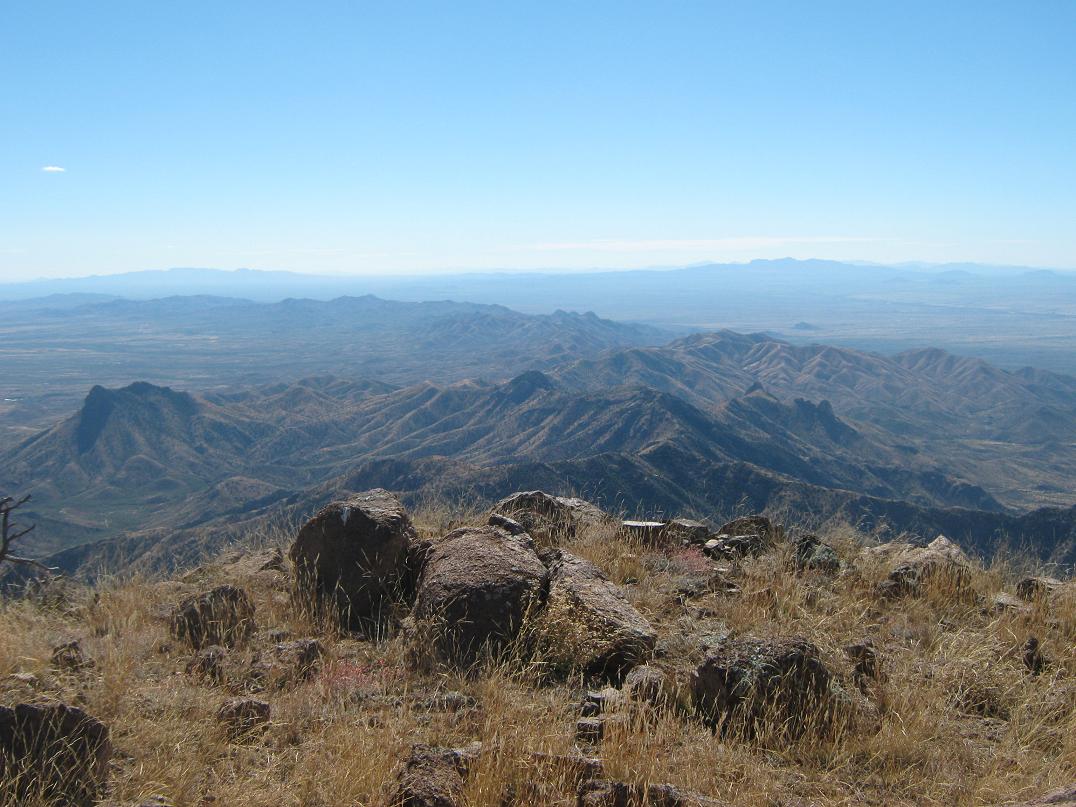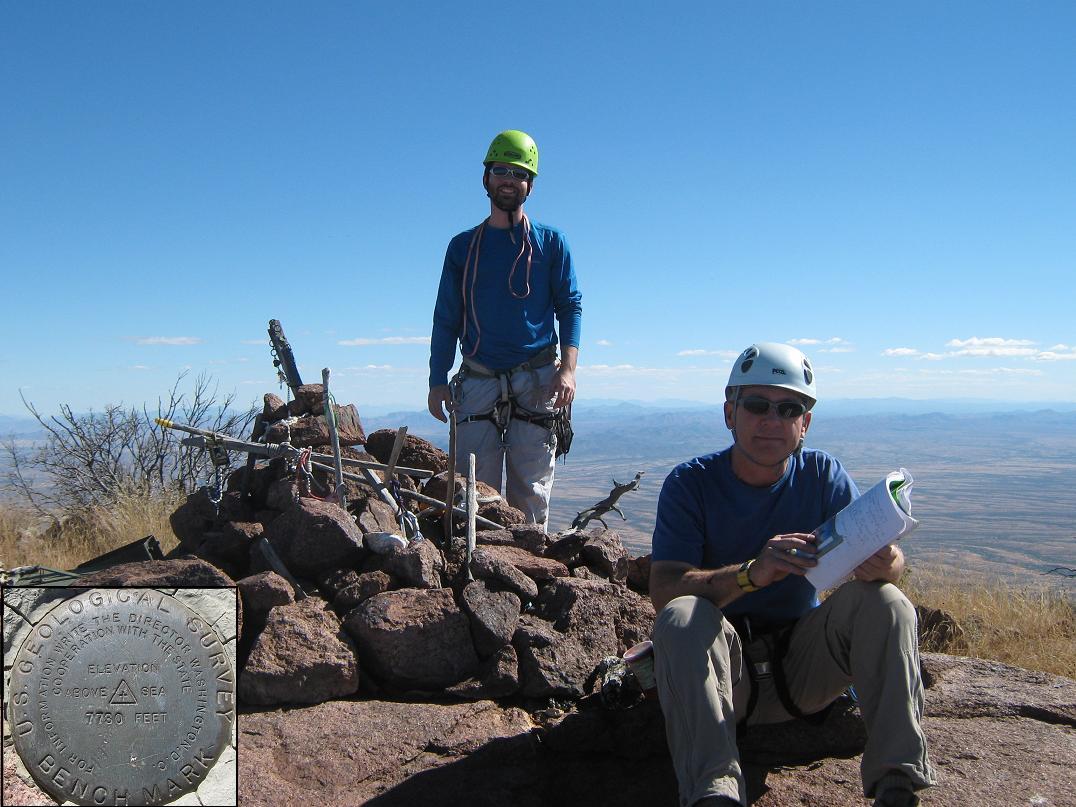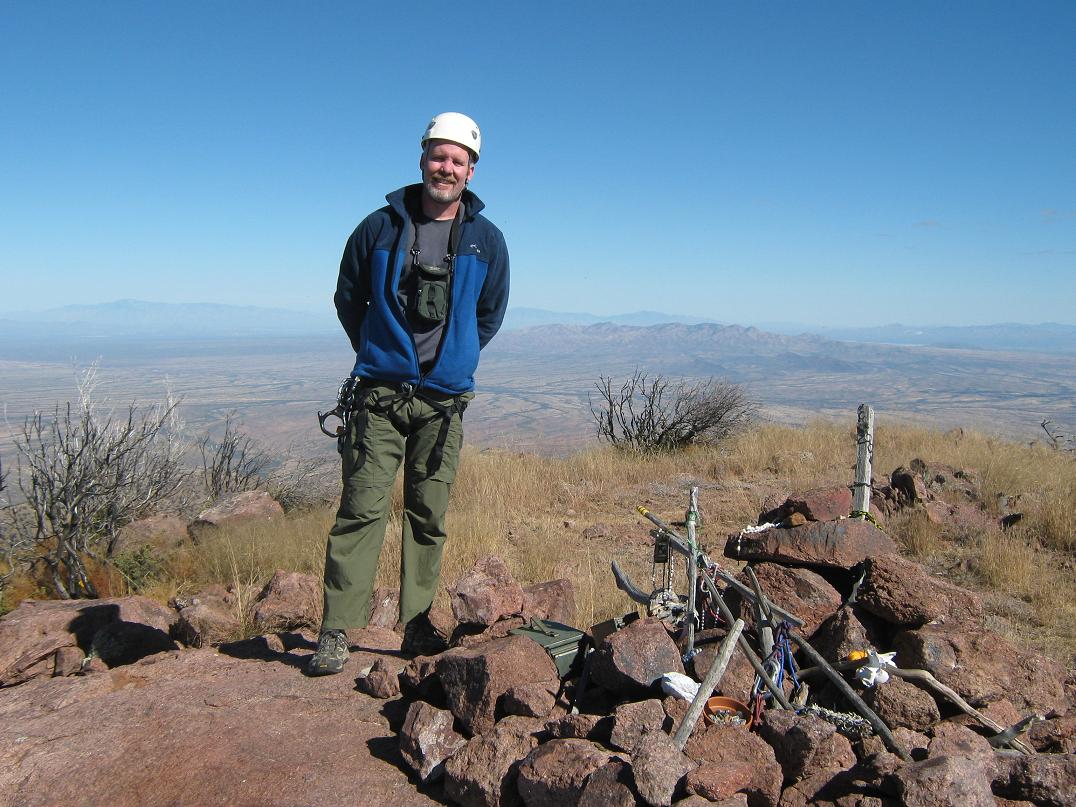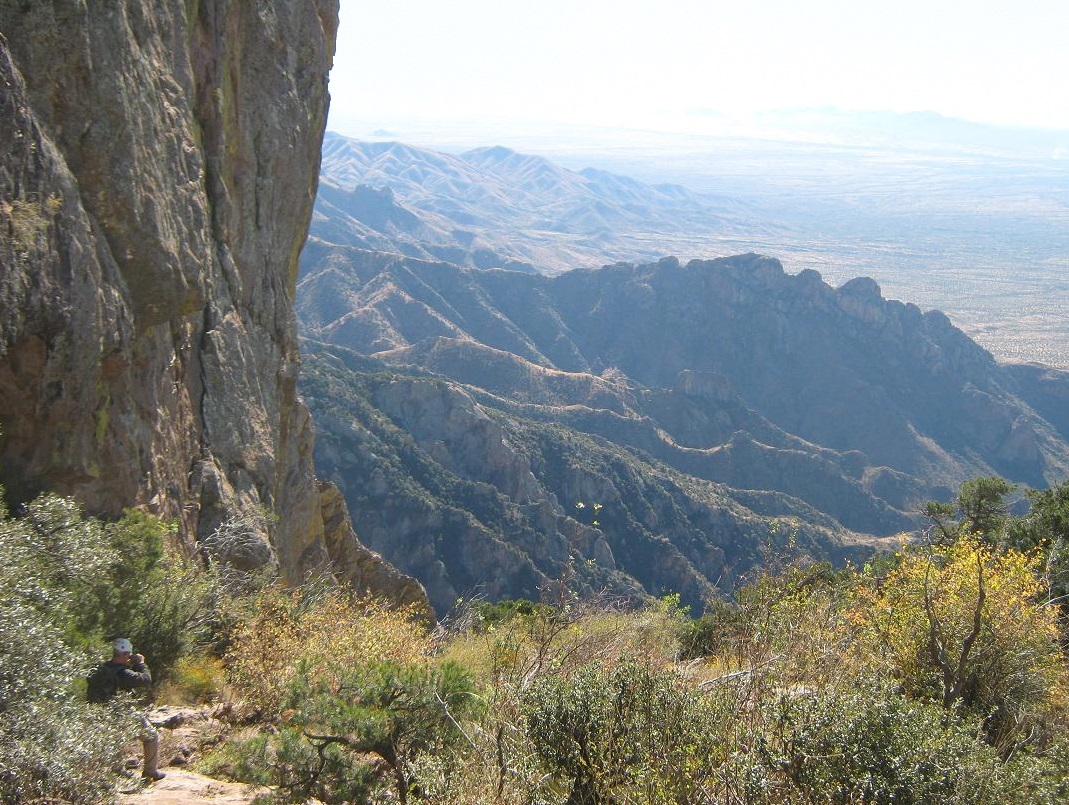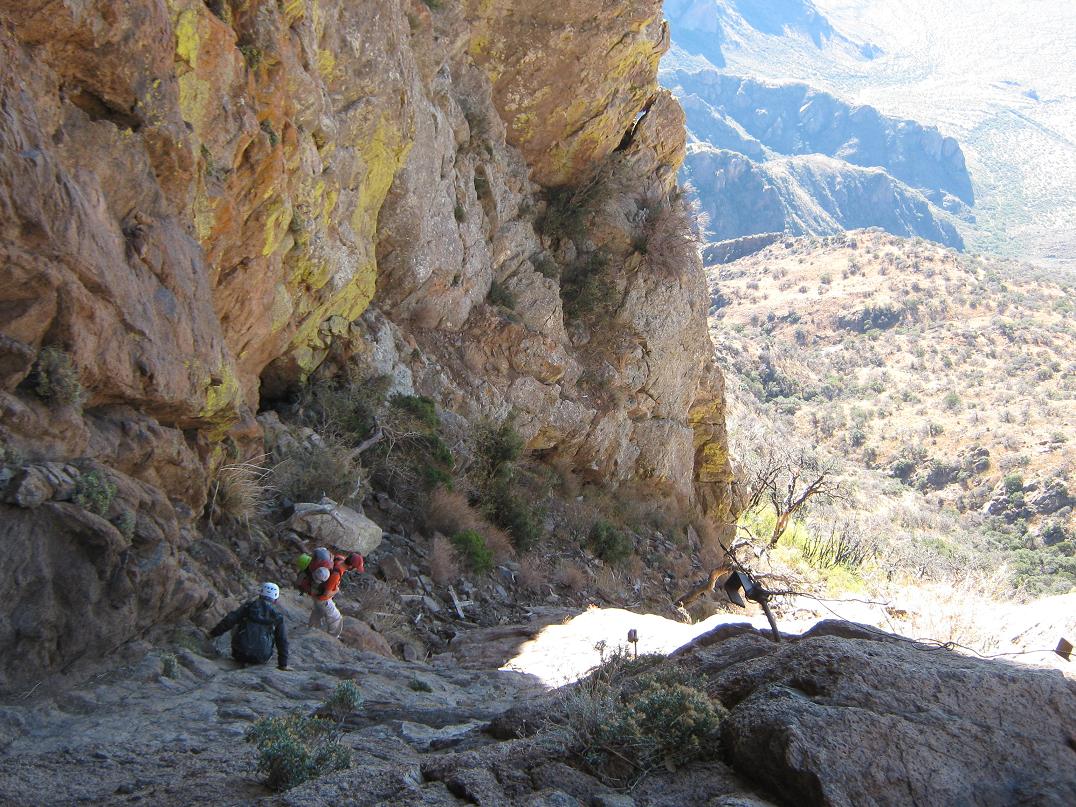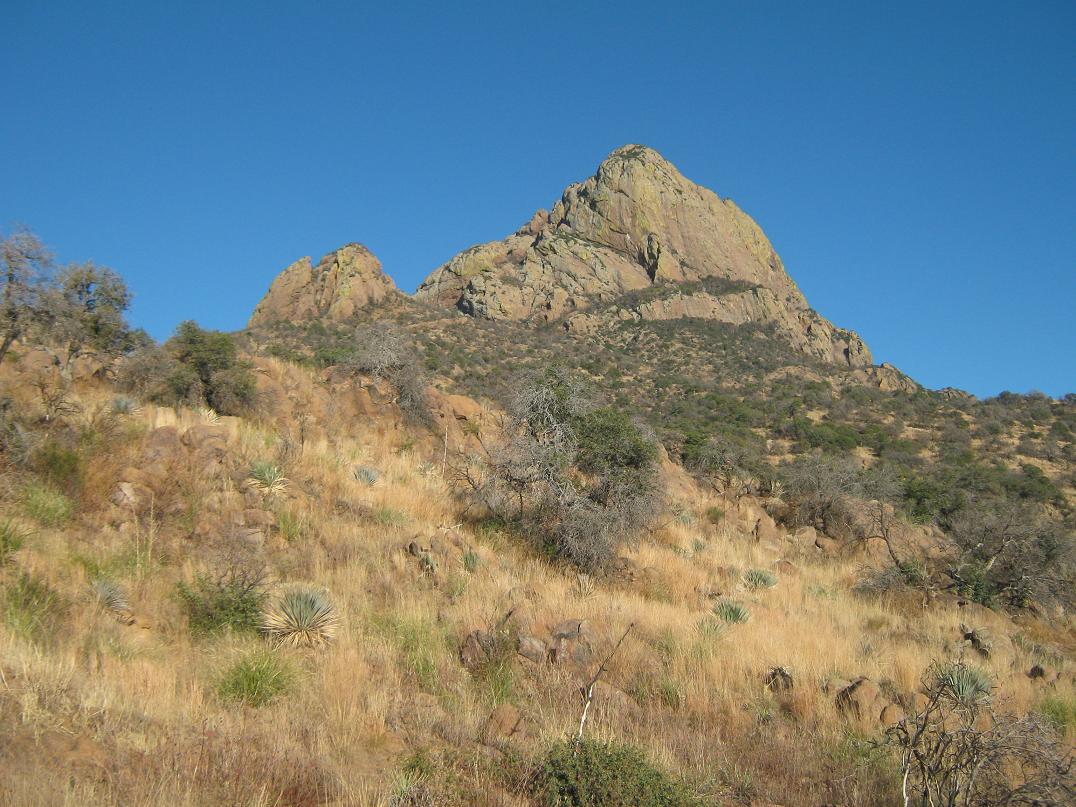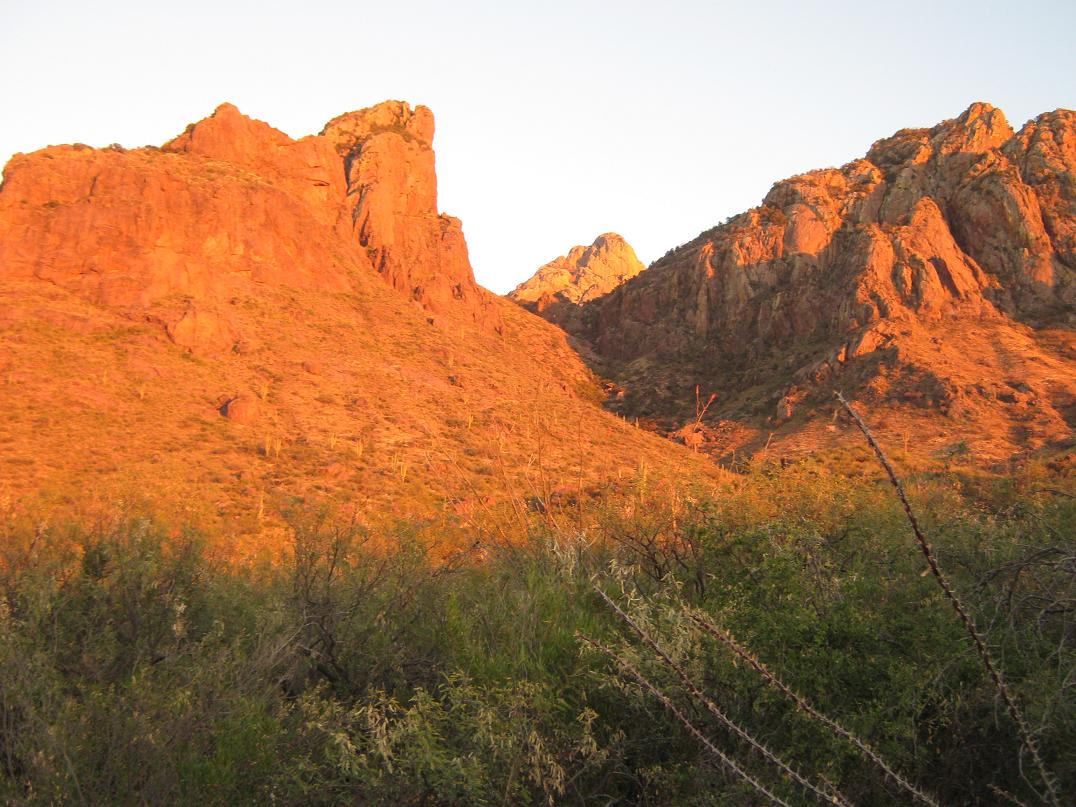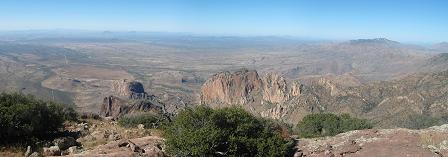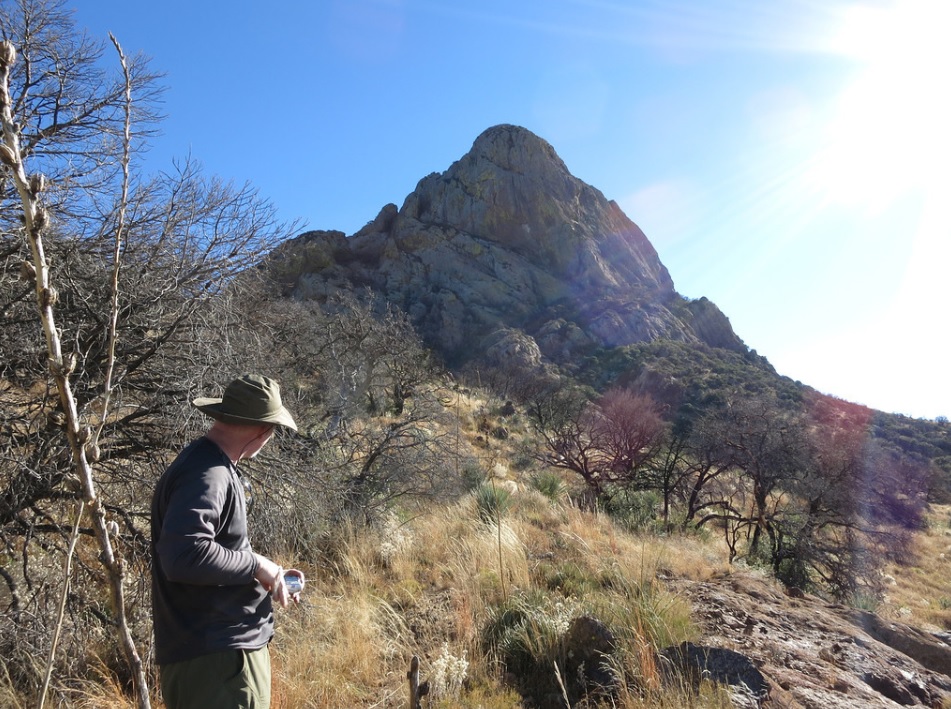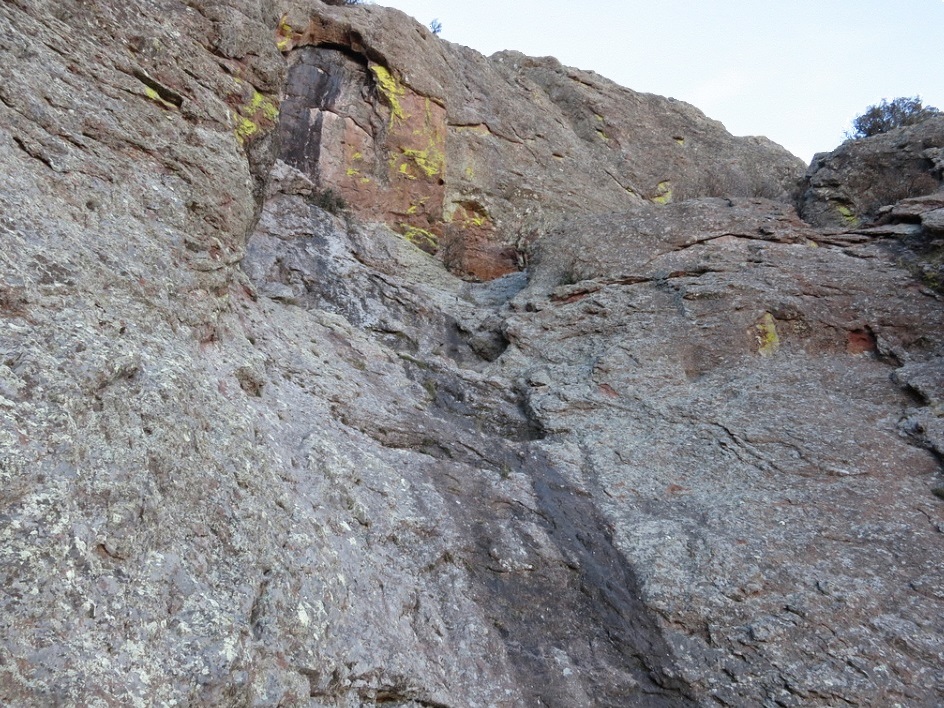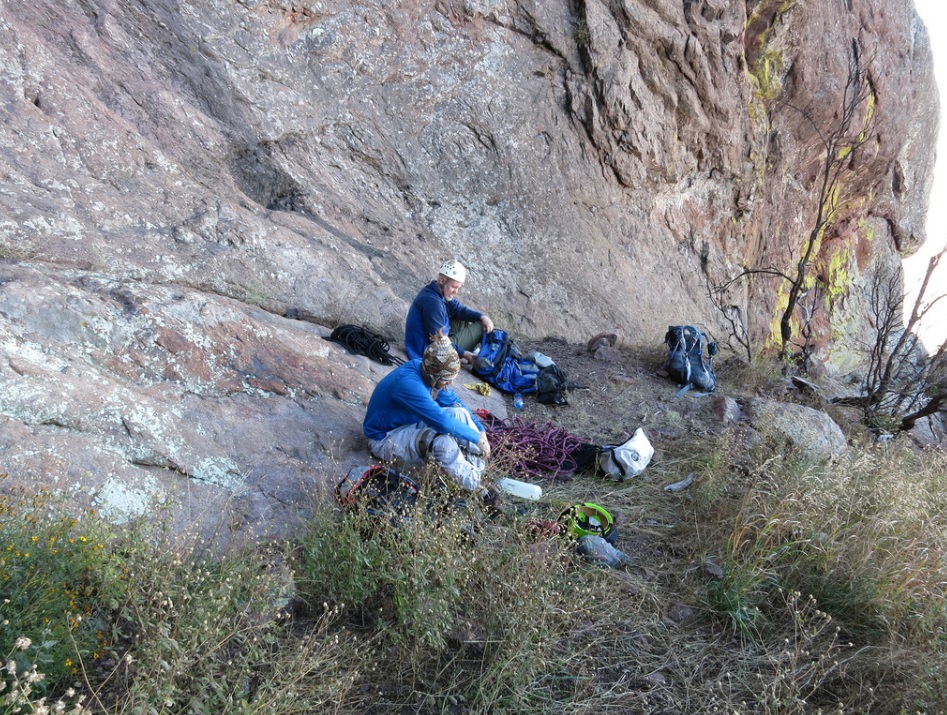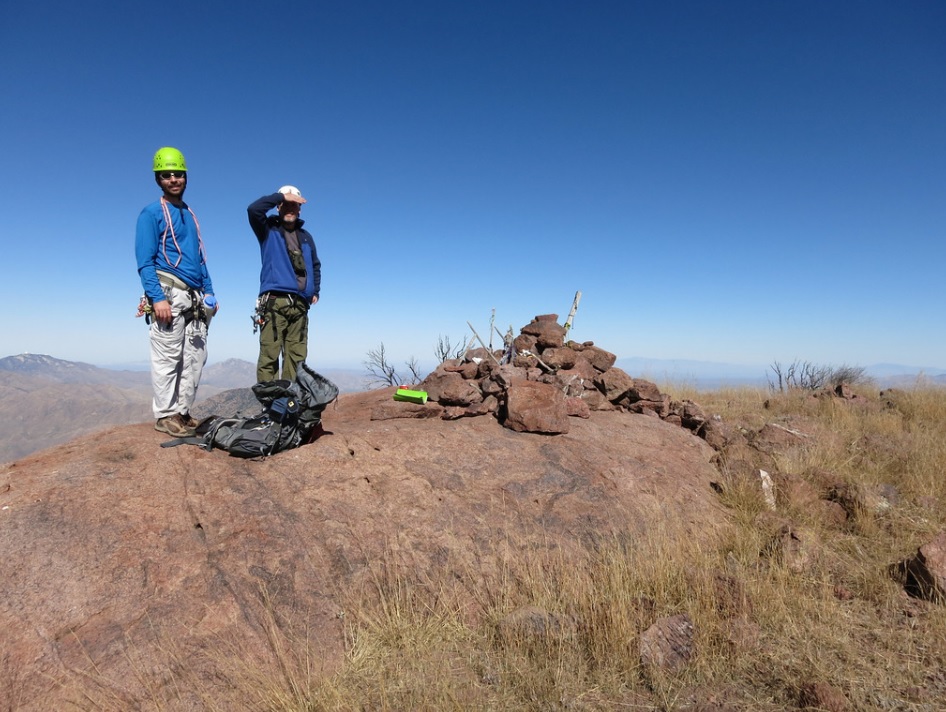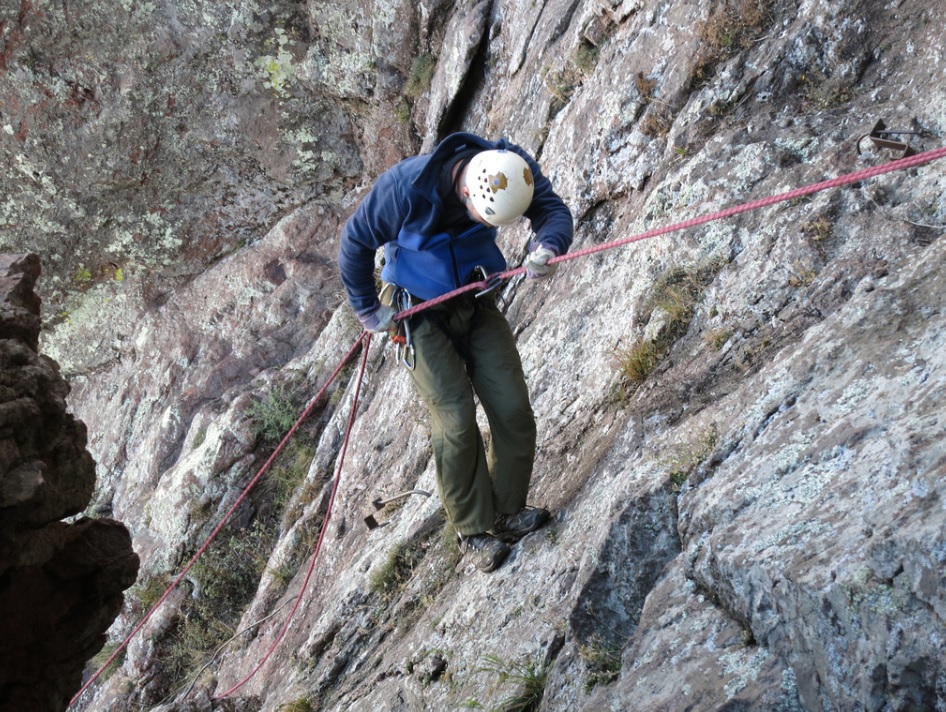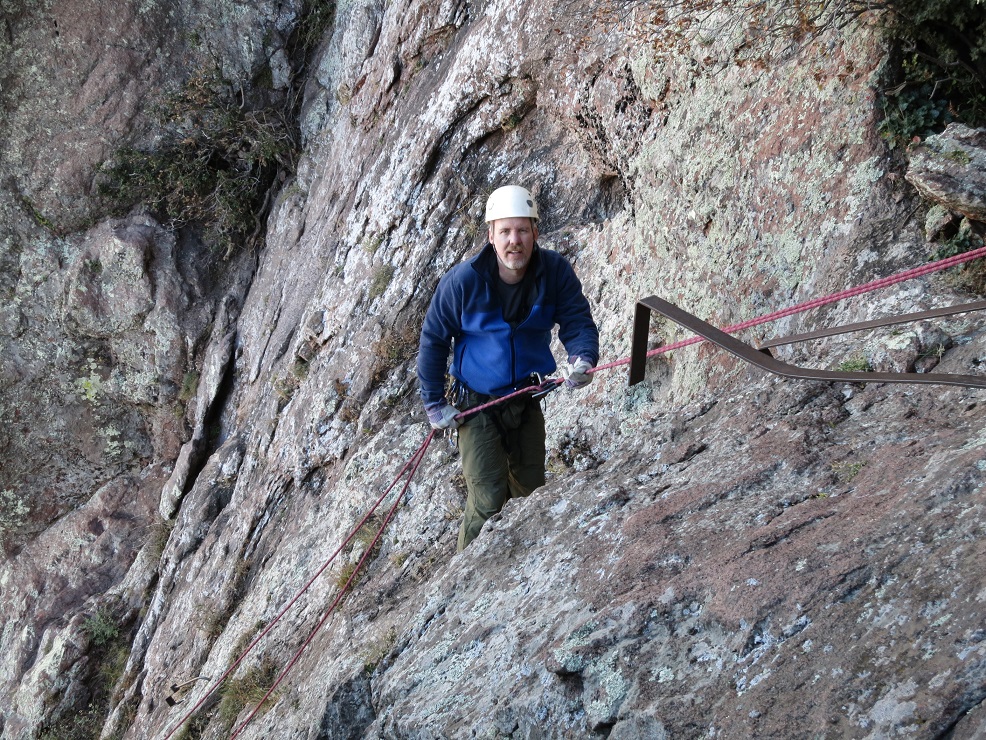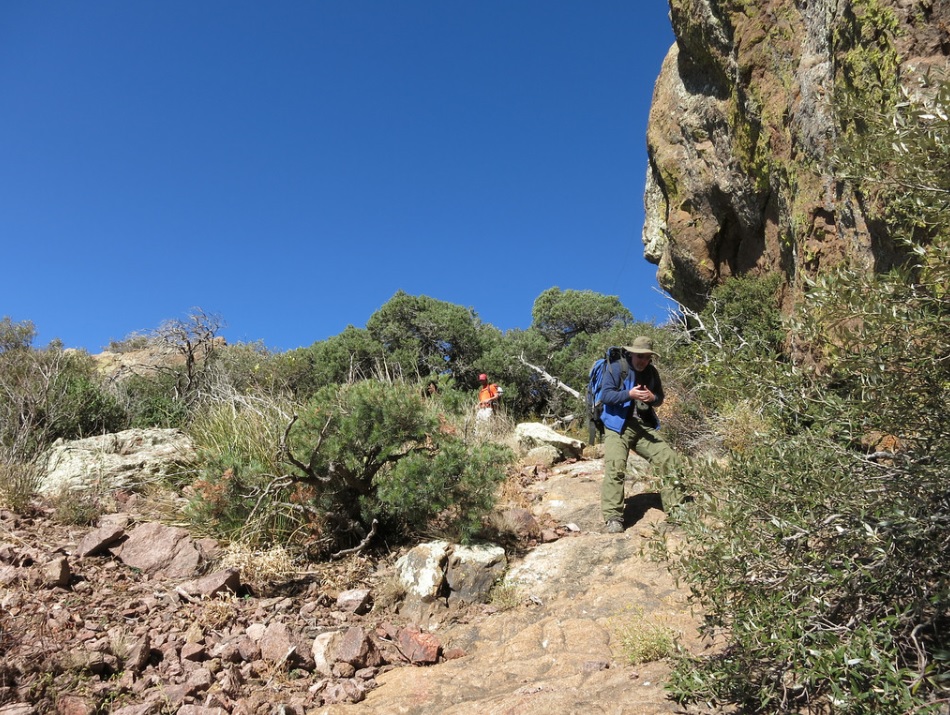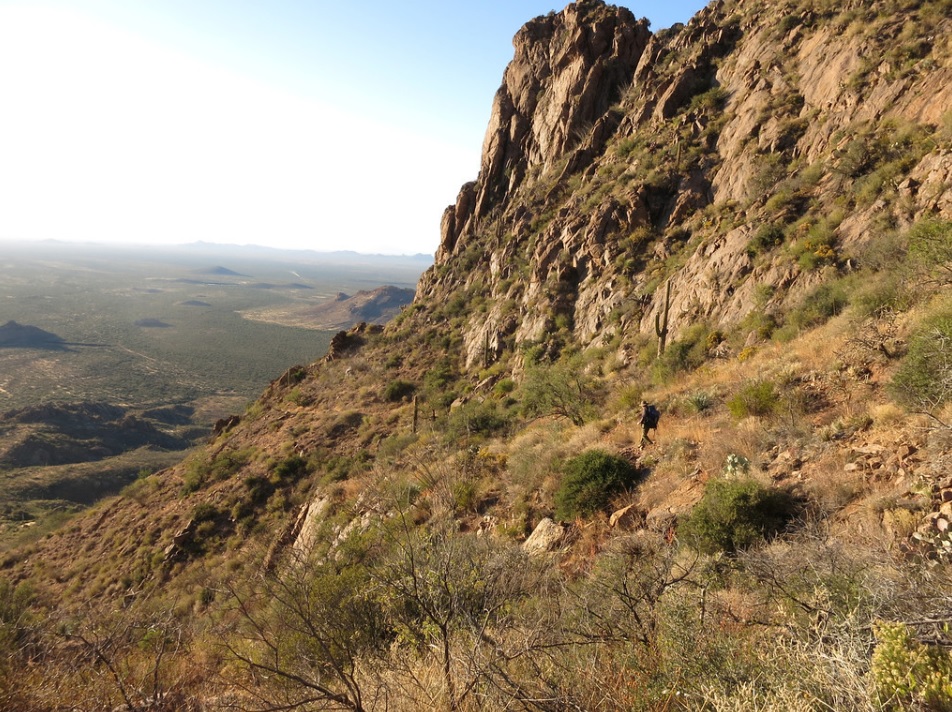
The Mountains of Arizona
• www.surgent.net
|
| Baboquivari Peak |
• Highpoint: Baboquivari Mountains • Highpoint: Baboquivari Peak Wilderness • Highpoint: Tohono O'odham Indian Reservation • Pima County |
|
Date: November 9, 2013
• Elevation: 7,734 feet
• Prominence: 4,194 feet
• Distance: 10 miles
• Time: 10 hours and 30 minutes
• Gain: 4,200 feet
• Conditions: Great weather
• Teammates: Scott Kelley & Scott Peavy
Baboquivari Peak may be the most iconic mountain in Arizona. It is a pillar of rock above the mountain ridges of the eastern Tohono O'odham Indian Reservation, visible from points in a hundred-mile radius assuming no obstructions. The mountain is sacred to the Tohono O'odham, home to its creator, I'itoi. The Tohono O'odham name for the peak is Waw Giwulk, as a newer trail sign mentions and thus later confirmed by a Tohono O'odham named James, a remarkable fellow we met on the descent (more on him later).
The peak looks unclimbable, but at worst, the rock section(s) are at the low end of the rock-climbing scale for difficulty. Depending on the route, these pitches aren't long, but vertical enough to scare off casual hikers. Expert climbers can virtually waltz up these faces, as we saw one guy demonstrate. But for a guy like me, it would pose a challenge. The rock-climb pitch would be the crux of the climb for me, as it is for most people. The other 4,100 vertical feet of gain is just routine, strenuous hiking and scrambling through spectacular Sonoran Desert mountain countryside.
I teamed with my fellow Scotts, Peavy and Kelley, with whom I have climbed on other peaks. We had planned to hike this peak as far back as April of 2012, but weather nixed that attempt. One other attempt got pushed back for some reason I don't recall. When the temperatures moderated, we set up a date once again to try our luck with Baboquivari Peak, and hope for the best. Kelley would be critical: he has ascended the peak twice before and has the necessary rock skills to lead the crux pitch. Peavy and I would need the protection of a top-rope belay.
I have to admit being intimidated by mighty Babo. I have viewed the peak dozens of times over the years. It is mesmerizing. Each time I'd think that someday I will have to test my skills on this magnificent peak. I was anxious for the few days leading up to the climb. I read the myriad of trip reports online, with accompanying photos. I spent those days trying to quell the nervousness and work up the courage.
We met at Kelley's place in Tempe at 2:45 a.m., with Peavy driving. We loaded our gear and starting the haul to Tucson, then into the Tohono O'odham Nation and into its main city, Sells. From there we drove south to Topawa, then east about 11 miles along a mostly-good road to the Baboquivari campground, arriving just after sunrise. The massive silhouette of Baboquivari dominated the sky as we drove in. I deliberately tried not to look. The weather was calm and pleasant. The day's high was to be in the 80s, meaning pleasant conditions much higher up. We parked near one ramada and started the hike at 6:55 a.m. From the campground, Baboquivari Peak looms high, framed by two massive cliff ridges. The scale is astounding.
We were approaching the peak from its west side, which meant for a longer hike with more gain than from the east, but it also meant we'd only have to deal with one rock-climb pitch, rather than three coming from the east. Kelley had his 60-meter rope and various climbing gear, while I also lugged a rope, a 100-footer. We all had our harnesses and helmets. My rope necessitated me using my bigger backpack, and including all other items I was carrying, my pack weighed close to 40 pounds.
The trail wanders through man-high scrub, then achieves the base of the mountains, gaining at moderate grades, generally trending southeast. We followed it as it made a long southward traverse, entering into a canyon south of the one from the campground. The trail switchbacks up the open slopes, and then bent east and made more long traverses. The gradients were often lenient, and the trail itself was well maintained. We just grunted forward and upward, working steadily east up this unnamed canyon. The trail makes one drop of about 50 feet here, the only point along the whole journey where we lost elevation. Not long after this section, the trail works steeply up to a ledge and from there, Baboquivari is once again visible.
We took a break here, having gained about 1,500 feet and covered about two miles. Babo was still maddeningly far away and higher up. The sun's angles hid the west face in shadows for the time being. We could see the ramps and ledges we would follow, but it still looked mighty difficult.
We continued upward, staying on the trail through grass, low scrub, and burned trees from a recent fire. I blanked out any thoughts from my mind and just thought about putting one foot in front of the other. It was tiring, but nothing I haven't done before. We crossed a migrant's path at one point, then gained higher into the trees, now on a lower, heavily-vegetated ramp (called the Lion's Ledge) that angles right as viewed from below. The trail gets a little overgrown here with thornbrush, but we never had any navigation problems. Finally, we had come to the rocky base of the peak itself. To here we had gained about 3,200 feet in a little over three hours. It felt good to get this long approach done, and to get to the real matter of the climbing.
Rising above and to our left was a bare slope of rock, the Great Ramp. Viewed from a distance, the Great Ramp makes a long left-trending sweep up this rock, and as is often the case, looks nearly vertical when viewed from afar. But now that we were upon it, it wasn't too steep, but still steep enough to demand care. To get to its base, we had to scramble up a loose slope of rock scree. Then we started the first "mini-crux" of the climb, the ramp itself.
The first 30 or 40 vertical feet is the steepest. My pack was shifting on me as I scrambled on all fours, so Kelley helped by ferrying it past one small section. Past this, the ramp's gradient lessens and becomes more vegetated. We stuck close to where it meets the cliffs, and had no problems whatsoever. The ramp took about 20 minutes to climb, and we were distracted by a Border Patrol helicopter buzzing far below us, clearly following some people. Migrants? Other hikers? Us? We did not know.
The ramp lets off at the base of the rock-climb pitch, called the Ladder Pitch. This section was pioneered by Dr. Forbes back in 1898. He ascended from the east and that whole route is called the Forbes Route. The Ladder Pitch gets its name from an old ladder that was once bolted into the rock to service a lookout tower atop the peak back around the 1930s. Here, we dropped the packs, got the harnesses on and started flaking the ropes. I stared at the wall and psyched myself up for this section. This would be a true test of my rock skills. I had climbed as high as 5.6 when in Mountain Rescue ages ago, but those routes went for maybe 30 feet. This one was about 60-70 feet, there being some route choices toward the top.
The plan was for Kelley to lead while I belayed. He carefully worked up the first 30 feet, placed some protection there and at another spot at about the 50-foot point. Finally, he was up top, and had secured himself to some permanently-placed chains near a small tree growing out of the rock. When he was secured, it was my turn to go. I have to admit, I was excited as hell. I was feeling as confident as I would ever feel. No time for negative thoughts now.
The easiest line from below angles slightly left, where there are good hand and footholds, usually just an inch deep, but stable. The rock itself provides a lot of friction. Still, I had to think each step carefully, planning each foot placement, then where the hands would go. The first goal is a ledge about 25 feet up. Once there, I cleaned the first pro, then shimmied slightly right and started up the remainder, at which point the rock leans back ever so slightly. The next goal was a more substantial ledge, this one about two feet wide. I took off the second pro, and just willed my ass up that slope. By now, I was near an exit ramp, a class-3 chute with giant handholds and footholds. I followed that up and onto a ledge, untied myself, and handed the rope back to Kelley so he could throw it down to Peavy for his turn. I sat there, thrilled as I have ever been. I had done something I had never done before, and the feeling of elation was wonderful.
Peavy worked his way up the pitch, taking it slow and deliberate, and in moments had convened with me on the ledge while Kelley pulled up the rope, and I coiled it from my position. We stashed it in a nearby bush and started up the remaining 400 vertical feet to the top.
Immediately after the ledge, we scrambled up an easy but wooded 15-foot slope, then down the other side where the trees grew thick against the rock. Within a few dozen feet from the initial ledge, we were at the last obstacle, a large chockstone on the left, the rock holding back thousands of tons of other rocks that form a gully. This was awkward and a tad dicey, but we got up it. Footing was tricky and there's a little outward lean that must be dealt with. Past this chockstone, we were on the last slopes to the top, these slopes just being steep and brushy, but not techncial at all. The slopes fed us to the summit. We had made it!
Getting here was a special treat. The top is a hump of rock, fairly large and gentle in appearance. An old lookout tower once stood up here, and at one time, a telephone line ran up the peak for the lookout's needs. We admired the views, shook hands and signed into the log book. The summit features a cairn on which are numerous trinkets, small gifts left behind by past climbers as an honorarium to I'itoi for granting safe passage. We did not doubt the custom, and left behind a small piece of webbing. In all, we spent about 20 minutes up here. What a magical place, a true thrill. I never thought I would get up here, and here I was. We took a well-earned break.
Now to descend. We walked down the slope, eased off the chockstone, and were quickly back to the rock-climb pitch. Kelly took the rope and eased out to the chains where he doubled it through a carabiner, readying it for the rappel. At this time, a group of three climbers were at the base, getting ready to ascend.
Kelley motioned me over and I attached myself to the rope through my figure-8, and started easing downward. This was more like a slow walk backwards than the rappels you see in movies where the guy jumps out from the wall in big dramatic leaps. I was down in about two minutes. The 60-meter rope, when doubled up, reached just a few feet above the base, so I was able to get all the way down with no trouble at all. My rope, which we'd brought along as a backup in case Kelley's rope wasn't long enough, was never needed. Once off rappel, I chatted with the other guys.
Their leader was also named Scott. He looked to be in his 50s, and looked like a long-time climber. He started to climb as Peavy was on the rappel. This Scott just walked up the slope, nimble and sure of himself, obviously an old pro. Peavy was soon down, then Kelley, while the other guys from the second team were starting up. It was just after 2:30 p.m.
We walked down the ramp and met up with another group of four climbers. They told us they were the ones being buzzed by the helicopters earlier in the day. They were friendly, but we were perplexed that they were still down here at this relatively late hour. The rock-climb pitch takes time, and they'd certainly be coming down after dark. I hope they have headlamps.
We got down that lower portion of the Great Ramp, where my pack was throwing me off balance again, Kelley helped by ferrying it in one part. Down that, we reconvened in the trees and had an extended lunch. Now all that remained was the long hike out. The day was spectacular, clear and gently warm, with a soft breeze. The walk-out would take a couple hours and be tiring, but trust me, there's nothing like a successful ascent of Baboquivari Peak to keep the mind at peace while hiking down 3,200 vertical feet.
On the walk out, I generally was ahead of Kelley and Peavy by a minute or two. We'd take breaks every half hour or so, and with the sun in the west, we took more photos. Still about a mile from the trailhead, I came upon a man sitting on a rock. He had clippers and was apparently doing some trail maintenance. He was a Tohono O'odham, a thoroughly cool fellow named James. Soon, the other Scotts were with us, and we chatted. James apparently works for the tribal park, and had asked us about seeing any groups of migrants. We hadn't, but he told us the previous week, a hiking club had come across a group of nine armed smugglers high up on the slopes where that migrant trail crossed.
James also gave us some sense of the place, what kind of things usually happen. The encounter with the smugglers was certainly interesting to us. James explained the smugglers will usually take the higher routes through the mountains, the migrants the lower routes. He also said that they'll avoid contact with hikers every chance they get. The encounter with that hiking club was apparently the result of the club catching them by surprise. In any case, we never felt in danger.
Finally, at 5:30 p.m., we were back at Peavy's car, where he had some of his home-brewed beers in a cooler. We enjoyed a half-hour post-hike break, drinking good beer, and watching the last of the sunlight fade from towering Baboquivari. Had I been up there not 5 hours ago? It was a thrill to be safely down and to have summitted this wonderful mountaintop. As it grew dark, we piled into the car and started the drive out. At some points on the drive, we could see glints of light high up on the peak, the other climbers, presumably. Why they started so late is a good question to ask.
James was in his truck and he gave us some tips on roads to follow so as to avoid one particularly rocky stretch. He had driven ahead, but just far enough for us to see his lights and follow him. He had said we'd come to a cattle grate, then go right, and that road would take us back to the main road. We got to the cattle grate and lost James, then turned right, following a much scanter two-track for about a half-mile. Was this the road he meant? We bailed and returned to the cattle grate, and saw a road that bent left slightly, then right. This was the road he meant. And there was James up ahead, his rear lights visible. He had waited for us while we lollygagged down that other road! What a cool dude, to wait up for us. Finally, back on the main road, James sped off to wherever he goes. We were back to the pavement soon, and from there, drove to Tempe via Quijotoa and Casa Grande. All of us universally agreed that James was a truly good guy. We were glad to have met him.
We were back to Kelley's place at 9:30 p.m.. I was bushed. I got my stuff into my truck, then drove home to Scottsdale, but I was hungry so I stopped at Denny's for a late meal. I was home by 10:30, the end of a long, fruitful and rewarding day. I could not believe that earlier this morning, I was setting off on this journey, and not knowing how the outcome would be.
I am indebted to Kelley and Peavy. Kelley's rock skills were critical to our success, and both are great teammates. Climbing Baboquivari is a singular thrill for me. In a way, it caps my long quest to climb all the 2000-foot prominence peaks in Arizona. Babo is the 68th out of the 73 that I have successfully climbed. Four of the remaining five have some sort of access issue, and one is just a brush-fest (Pinnacle Ridge) that I bailed on in April and have yet to work up the interest to retry it. Barring some unforeseen luck on gaining access to these other peaks, I am essentially done with this project, and in a way, I am thrilled to have finished on Baboquivari, the best mountain in the state. Whatever other peaks I climb from this list will be gravy.
Now that I'm an "expert" on Babo, here are some of my comments about the peak. First, get an early start. Be hiking at sun-up. It's going to be a long day even for fast movers. If you get to the Ladder Pitch and there are already people there, it can take time to get everyone up. The potential for a bottleneck is there. For the rappel, a 60-meter rope, when doubled up, reaches perfectly to the base below, maybe a couple feet above it. Experienced climbers will find the pitch to be easy. Those who know better than me would rate it about 5.3-5.5ish for the first 20-30 feet to the first ledge. Then it lies back a little and would rate (in my opinion) 4-plus, or 5.0 (To me, it's still more "climby" than "scrambly"). Be aware that the rock pitch is almost always shaded and could even be covered in a thin coat of ice if the weather is cold and it has rained/snowed previously. Late Spring and Mid Fall (October and November) are dependable, usually. Also, the recent fire has created conditions for erosion on the trails and some of the slopes. In places, large rocks are very loose, so move carefully. I wouldn't necessarily worry about meeting with migrants or smugglers. Snakes, yes. Keep an eye for them as the grass can grow thick alongside the trail. Be respectful of the land, leave a gift for I'itoi, and if you see James, say hi for us.
|
|
